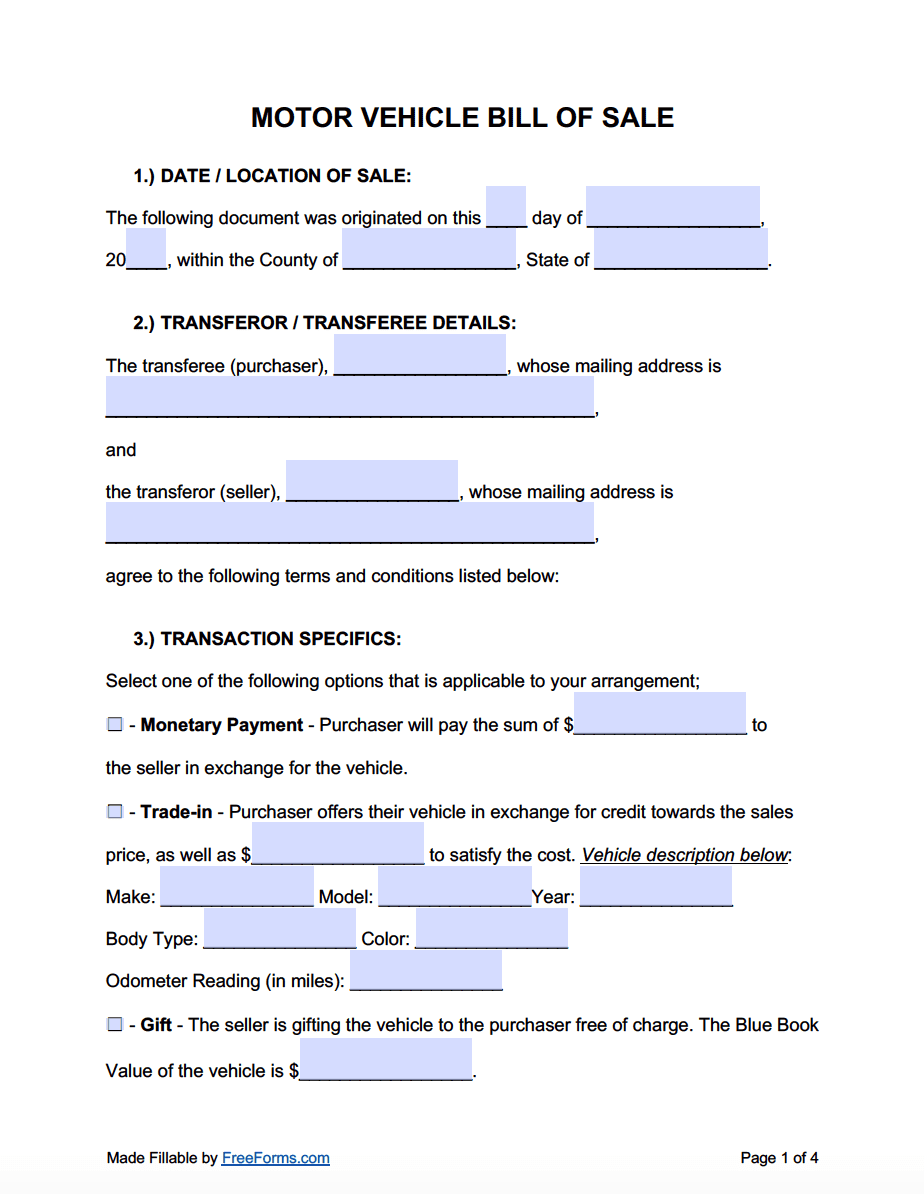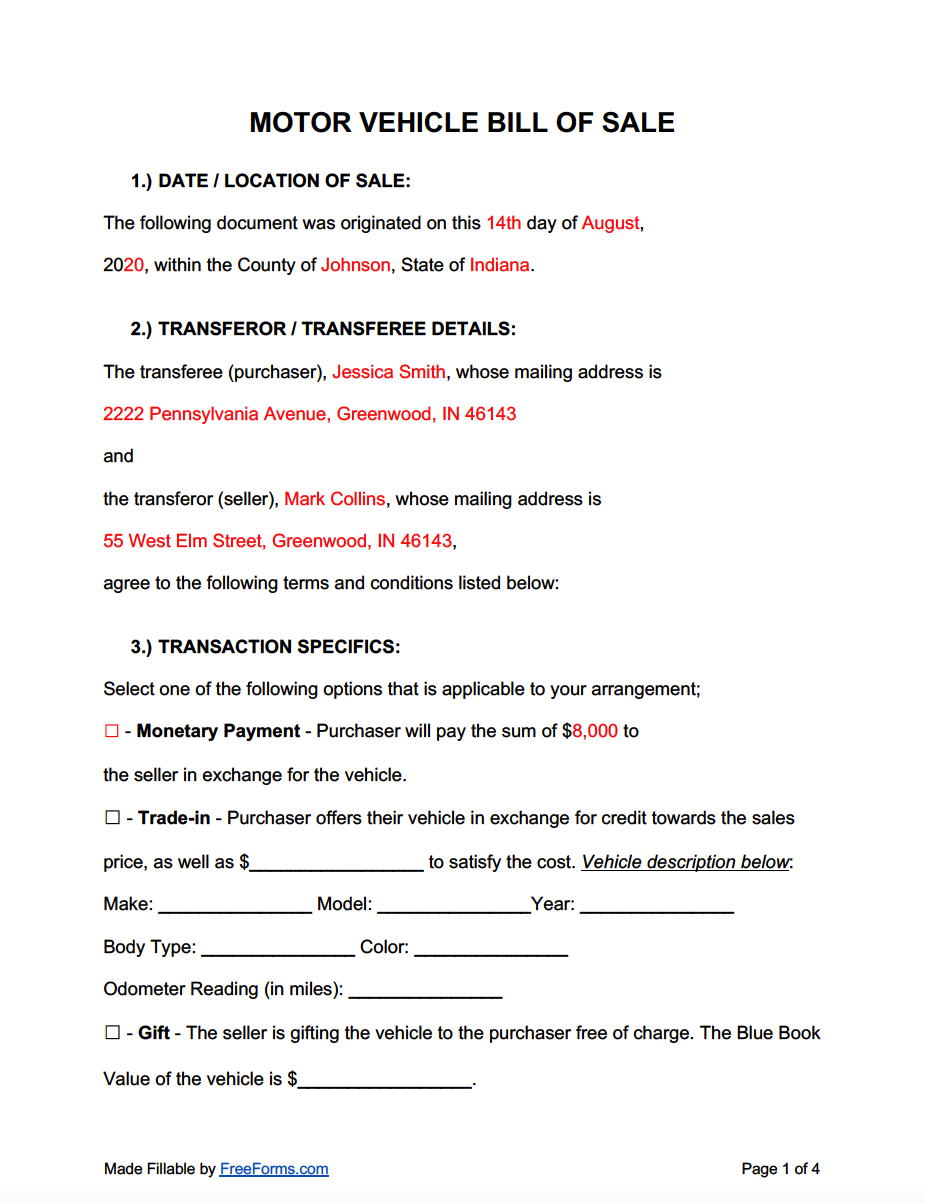The motor vehicle (DMV) bill of sale form is put into practice when a person wants to convey ownership of their pre-owned automobile to another individual for a sum of money (the vehicle may also be traded or gifted). Users will report certain aspects of the sale within the document, creating a tangible record of the transaction. Some of the vital particulars that the form requires is the vehicle’s details (make, model, year, etc.), participant contact information, and purchase price. Once all the data has been recorded, both the buyer and seller will provide signatures to complete the document. (It is important that both parties keep a copy as a safeguard in case of any future discrepancies.)
BY STATE
- Alabama
- Alaska
- Arizona
- Arkansas
- California
- Colorado
- Connecticut
- Delaware
- Florida
- Georgia
- Hawaii
- Idaho
- Illinois
- Indiana
- Iowa
- Kansas
- Kentucky
- Louisiana
- Maine
- Maryland
- Massachusetts
- Michigan
- Minnesota
- Mississippi
- Missouri
- Montana
- Nebraska
- Nevada
- New Hampshire
- New Jersey
- New Mexico
- New York
- North Carolina
- North Dakota
- Ohio
- Oklahoma
- Oregon
- Pennsylvania
- Rhode Island
- South Carolina
- South Dakota
- Tennessee
- Texas
- Utah
- Vermont
- Virginia
- Washington
- West Virginia
- Wisconsin
- Wyoming
Do I Need a Motor Vehicle Bill of Sale?
In some states, it is mandatory that all individuals taking part in the sale/purchase of an automobile carry out a bill of sale. Other states may not require the execution of this agreement, but it is still suggested to fulfill as it can be very beneficial to have a physical record on hand. The buyer may present the document to the DMV in order to disclose the purchase price and pay the necessary sales tax when registering the vehicle. The seller should also retain a copy as it can provide evidence that they are no longer liable for the vehicle.
How to Privately Sell a Used Car
If you are looking to sell your used car, there may be some things you should consider. A lot of times people feel timid at the thought of marketing and selling their own car, and instead, sell their vehicle to a dealer. The truth is that the dealerships typically undercut the value of your car so that they can make a substantial profit. So what we have done is created a step-by-step process showing how you can sell your vehicle privately for the best price.
Step 1 – Pricing the Vehicle
The first thing that is going to need to be addressed is the price. What is the vehicle worth? The most popular way of figuring this is by using Kelly Blue Book. You can look up your car’s value by providing information such as the vehicle details, condition, and any extra features it may have. Once you input all the necessary information, KBB will calculate the value of the vehicle. They provide a “Trade-in Value” and “Private Party Value” (you may notice that the PPV is higher than what you would get for a trade-in).
Step 2 – Collecting the Paperwork
When you’re getting prepared to sell your car, it is important to have all the vehicle’s paperwork readily available. A missing title can take days, even weeks to receive a duplicate copy from the state. That’s why it is essential to collect the necessary documentation prior to meeting with potential buyers. Be sure to gather the following paperwork:
- Bill of Sale (2 blank copies for each party to complete upon transfer)
- Certificate of Title
- Current Registration
- Receipts for Repairs and Maintenance
- Inspection Certificates
- Vehicle Warranty Information
- Odometer Disclosure Statement
- Vehicle History Report
Step 3 – Advertising Your Vehicle
Once you have established your vehicle’s worth and have all the necessary paperwork at your fingertips, it’s time to list the vehicle for sale. In the past, people were limited to only a few different types of advertising outlets. The standard used to be posting an ad to a local newspaper or magazine, or putting a “for sale” sign on the car and parking it along a busy street. Luckily today, the internet enables us to reach a far greater audience by using some of the classified ad websites that we have at our disposal. Some user-friendly websites that are great for advertising automobiles would be:
- AutoTrader – One of the most popular websites that specifically caters to the online sale and purchase of automobiles.
- eBay Motors – The website “eBay” contains its own motor vehicle division that is dedicated to the sale of cars and trucks.
- CraigsList – Advertise to local buyers by going to the “for sale” section and posting under “cars+trucks”.
Step 4 – Coordinate a Meeting with a Potential Buyer
After posting your ad, it is only a matter of time before you start receiving emails and calls regarding your vehicle. Be prepared to answer any questions concerning the car. If the inquiring party is interested, schedule an appointment to meet at a specific time and place to show them the vehicle. Be sure to thoroughly clean the vehicle inside and out prior to the encounter, making sure that it is in top-notch condition. At the showing, allow the interested party to inspect the car and be sure to disclose any pertinent details related to the vehicle. (Note: Sometimes a buyer will request a pre-purchase inspection before committing to any type of sale.)
Step 5 – Coming to an Agreement
If interested in purchasing the vehicle, the buyer and seller should discuss how the transaction will unfold. Sometimes the buyer is willing to pay the full listing price which makes it easy for the seller, but a lot of times the buyer will want a discount on the initial asking price (keep this in mind when pricing your vehicle, it is always good to have a little wiggle room for negotiations). It is the seller’s decision to accept the offer, propose a counteroffer, or decline the bid. If both parties come to an agreement on the price, they will have to deliberate on what form of payment will be used for the exchange of the vehicle.
Step 6 – Method of Payment
An important aspect of how the exchange will transpire involves the form of payment that the buyer will provide to the seller. The best options include the following:
- Cash – This is the safest option for the seller.
- Certified or Cashier’s Check – The second best option to cash. Although these 2 types of checks are guaranteed by the bank, there is still potential for fraud. To ensure that the check is legitimate, it is suggested that you meet the buyer at the bank that issued the check to confirm that it is valid.
- Personal Check – You should only accept this method of payment if you make a stipulation that you will only transfer the vehicle once the check clears. You may also meet the buyer at his or her bank to cash the check.
To tie in the sale, you will want a receipt for the transaction. Both parties should complete and sign a copy of the bill of sale to store for their vehicle’s files.
How to Write a Motor Vehicle Bill of Sale
Step 1 – Download in Adobe PDF or Microsoft Word (.docx).
Step 2 – Time & Place of Sale – The initial section requests that users input the following details regarding the exchange:
- Date (day, month, last 2 digits of the year)
- County
- State
Step 3 – Purchaser/Seller Info – Enter the following particulars specific to the individuals taking part in the transaction:
- Transferee’s (Purchaser’s) Name & Address
- Transferor’s (Seller’s) Name & Address
Step 4 – Terms of the Exchange – Specify the terms of the sale, trade, or gift within this designated portion of the form. You have the options of selecting:
- Monetary Payment – For buyers who are purchasing the vehicle for the full listing price. Enter the sale amount (numerically, in dollars) into the space provided.
- Trade-in – Check if the seller agrees to accept the buyer’s vehicle as payment towards the primary automobile, then enter the remaining money owed (if any) and the trade-in vehicle’s information.
- Gift – If the seller is conveying ownership of the vehicle to the buyer for free, select this option and insert the estimated value of the property.
Step 5 – Primary Vehicle Description – Identify the automobile being sold by supplying the agreement with the following information relating to the vehicle:
- Make
- Model
- Year
- Body Type
- Color
- Odometer Reading (in miles)
- VIN Number
- Select one of the 2 options regarding the vehicle’s sales tax:
- “All municipal, state, & county taxes are included within the sales price.”
- “Taxes are not included within the sales price.”
- Additional Provisions (if applicable)
Step 6 – Signatures – The seller, purchaser, and 2 witnesses must join together to perform/accomplish the following requirements:
- Seller’s Signature & Printed Name
- Purchaser’s Signature & Printed Name
- Witness #1’s Signature & Printed Name
- Witness #2’s Signature & Printed Name
(In order to notarize the agreement, all signatures should be executed under the observation of a notary public.)
Step 7 – Odometer Disclosure Statement – This form comes conveniently equipped with an odometer disclosure statement that can be fulfilled by providing the following:
- Seller(s) Name(s)
- Odometer Reading (mileage)
- If there is a discrepancy pertaining to the reading, you may select one of the following statements:
- “I hereby declare that the odometer reading shows the total number of miles in excess of its mechanical limitations.”
- “I hereby declare that the odometer reading is not the actual mileage.”
- Seller’s Signature & Printed Name
- Purchaser’s Signature & Printed Name
- Witness #1’s Signature & Printed Name
- Witness #2’s Signature & Printed Name
Sample Motor Vehicle Bill of Sale
Download: Adobe PDF, MS Word (.docx)




0 comments
Comments are closed.